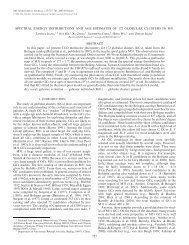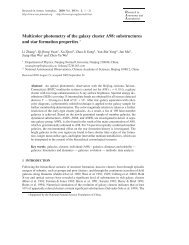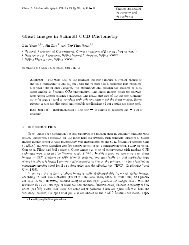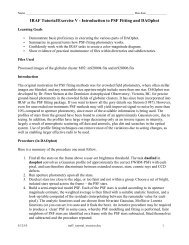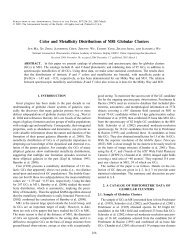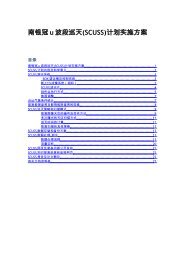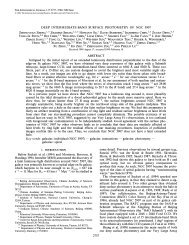Wu,J.H.,Peng,B.,Zhou,X.,Ma,J.,Jiang,Z.J.,Chen ... - BATC home page
Wu,J.H.,Peng,B.,Zhou,X.,Ma,J.,Jiang,Z.J.,Chen ... - BATC home page
Wu,J.H.,Peng,B.,Zhou,X.,Ma,J.,Jiang,Z.J.,Chen ... - BATC home page
You also want an ePaper? Increase the reach of your titles
YUMPU automatically turns print PDFs into web optimized ePapers that Google loves.
No. 4, 2005<br />
OPTICAL MONITORING OF S5 0716+714 1825<br />
Fig. 6.—Color index vs. brightness on JD 2,453,006. The solid line indicates<br />
only a very weak correlation between the color index and brightness.<br />
of the resulting variation depend on the power spectrum of the<br />
turbulence and the shock thickness. This kind of shock-injet<br />
model will naturally lead to the prediction of a bluer-whenbrighter<br />
phenomenon (<strong>Ma</strong>rscher 1998), as observed in our case.<br />
The shock-in-jet model still suffers from a number of problems<br />
in explaining IDV, such as the close correlation between<br />
the radio and optical variations. Therefore, geometric effects are<br />
sometimes invoked to account for some observational facts that<br />
cannot be interpreted satisfactorily by the shock-in-jet model.<br />
Geometric modulation in the context of shock-in-jet models is<br />
detailed by Camenzind & Krockenberger (1992). They argued<br />
that knots of enhanced particle density are injected at a finite jet<br />
radius. In knots moving relativistically on helical trajectories,<br />
the direction of forward beaming varies with time. For an observer<br />
close to the jet axis, the sweeping of the beam will introduce<br />
flares as a result of the lighthouse effect. This will lead<br />
to quasi-periodic variations of a few oscillations; the variations<br />
are basically achromatic.<br />
It is tempting to examine the color change on only JD<br />
2,453,006, since perfect sinelike light curves were observed on<br />
that night. Figure 6 illustrates the color index versus brightness<br />
relation. The linear fit gives a slope of 0.256, which is very<br />
different from the overall slope of period 2. The correlation<br />
coefficient is 0.361, and the significance level is 0.170, which<br />
means a poor fit or no clear correlation between the color index<br />
and brightness. That is to say, the brightness changed nearly<br />
achromatically on JD 2,453,006. The only two known processes<br />
that can cause achromatic variability are microlensing<br />
and the lighthouse effect. Although microlensing has been ruled<br />
out as the dominant mechanism of the variability of S5 0716+<br />
714, it may still make some contribution. The symmetry in the<br />
sine light curves may indicate a microlensing event, but the concave<br />
shape of the second halves of the light curves cannot be<br />
explained in terms of microlensing. In addition, this very short<br />
timescale would require a transverse speed of v trans c when<br />
microlensing. Therefore, the most probable mechanism responsible<br />
for the sine light curves is the lighthouse effect. It<br />
may produce a periodic variation according to Camenzind &<br />
Krockenberger (1992); the variation is achromatic. In other<br />
words, the variation observed on JD 2,453,006 is likely due to<br />
geometric effects.<br />
It is unclear whether all fast IDVs, especially the quasiperiodic<br />
ones such as those observed by Quirrenbach et al.<br />
(1991), can also be explained in terms of geometric effects<br />
within the context of the shock-in-jet model. If the answer is<br />
yes, the actual timescales of the intrinsic flux changes will be<br />
longer by a factor of a few, and the deduced extremely high<br />
brightness temperature will be reduced by 1 or more orders of<br />
magnitude. This will help to resolve the large difference between<br />
the high brightness temperature (10 17 K) and the<br />
Compton limit (




